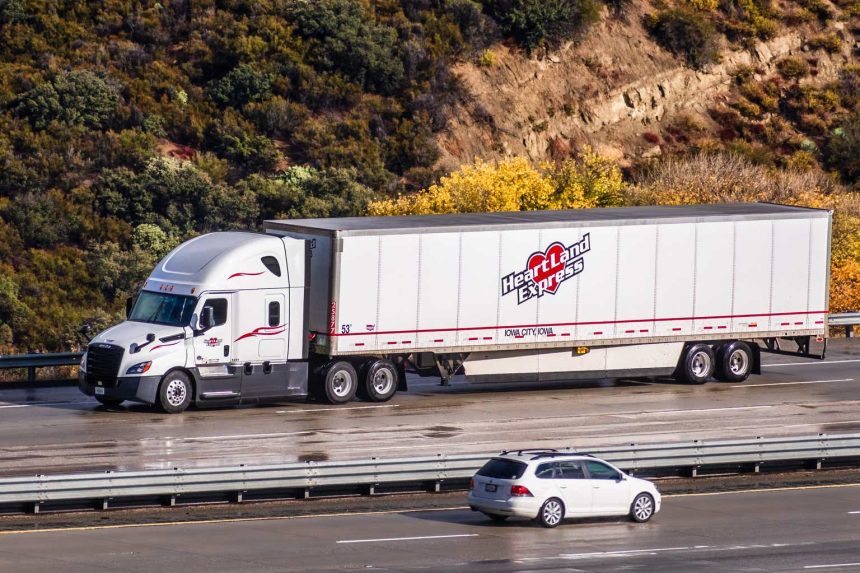When I last wrote about Heartland Express (NASDAQ:HTLD), I commented that at that point in the trucking cycle it felt as though any lights at the end of the tunnel turned out to be oncoming trains, and so it has continued to be the case. With inventory destocking adding further pressure to volumes and rates, conditions in the trucking sector have remained pretty miserable, dragging Heartland down another 20% or so since my last update.
With Heartland underperforming Knight-Swift (KNX) and Werner (WERN), I wonder if at least some of the issue isn’t tied to the nature of the freight Heartland carries (consumer has generally been weaker), as well as ongoing headwinds from lower gains on equipment sales and the integration of recent acquisitions (Smith and CFI).
As much as I’m tired of being wrong about these shares, and I do see a risk of weakness throughout 2024 as equipment gains will likely be low and I think volume weakness is a real risk, it’s hard not to have some interest in the shares as a contrarian turnaround story. You have to press your thumb pretty firmly on the scale to make today’s valuation seem reasonable, and I do think quality operators like Heartland will recover. All of that said, the Street doesn’t care about 2025 that much (let alone 2026), and I do see risks to expectations from a weakening macro environment.
Looking Ahead To Q2 Results – Stability With An Eye Toward Recovery
Heartland has seen sequential declines in revenue since the fourth quarter of 2022, but I believe that will end with Q2’24 results (and that is also the Street average assumption). Volumes have been picking up modestly across the sector, and I think Heartland will see some improvement. Overall revenue will still be down by about 10% and pricing is still rough, but Heartland’s policy of holding the line on pricing and relying on contracted volumes (as opposed to brokered freight) should help some.
I am also looking for the company to be at or just above breakeven for adjusted operating income, and that’s slightly better than the average analyst expectation. Management has continued to focus on cost control and while the current state of volumes doesn’t help the process of bringing the margins at Smith and CFI in line with the rest of the company, I do think there will be enough progress to get back to breakeven.
I’m not expecting much in the way of gains on equipment sales, as the company has been letting its fleet age creep higher (2.4 years for tractors in Q1’24 versus a target below 2.0) in response, I believe, to weaker demand as small carriers pull back significantly on capex.
And Then What Happens?
This is the part of the story that gets a lot shakier. As I’ve said in other articles, I’m not bullish on the macro outlook for the U.S. in the second half of the year. I think it is more likely than not that companies that were forecasting meaningful second half improvements are going to rein in those expectations with Q2 or Q3 earnings/guidance, and I’m not seeing much on the retail / consumer side that suggests spending is going to start moving in a more positive direction (retail sales have been weakening, though are still up year over year).
Although tonnage did grow in May for the sector, shipments were down, and I’m concerned that without more meaningful inventory re-stocking, there won’t be much momentum on volumes. While Heartland doesn’t provide much insight into its business, historically more than 50% of volumes have been in the retail/consumer category (and another 25% in food/beverage), so for Heartland it’s really more a question of whether consumer demand picks up for its contracted customers (though it is also true that truckload carriers can shift between freight types).
Pricing was weak in the first quarter of 2024, though Heartland’s contracts and refusal to accept low-ball bids should shield them to some extent. Rates have been improving recently (spot rates up 5% from April through July), but I don’t have a lot of confidence that this will persist unless volumes pick up. Weak conditions have pushed more operators out of the market, and I suspect the recent increase in spot rates may be a byproduct of that (and/or shippers turning to the spot market when trucking companies refused low-ball contract bids).
I do think spot rates should improve as the year goes on unless volumes really fall off. That won’t help Heartland this year, but it will at least set the stage for better pricing negotiations early in 2025.
Moving down the income statement, I don’t expect gains on equipment sales to be a meaningful driver this year, and I think 2025 could be sluggish there as well, with small carriers being cautious about adding capacity (or simply not being able to afford to given where shipping rates and interest rates are). I do expect more progress in integrating Smith and CFI, but Heartland management has acknowledged in the recent past that weaker volumes were slowing down the process, and they stretched out the timeline from three years to four years for normalized operating ratios (that is, bringing Smith and CFI in line with legacy Heartland and Mills).
One other item I’m watching is the ratio of wages to revenue. As part of its policy to reward loyalty and competence (and to improve driver retention), Heartland does offer pay floors to some of its drivers, and this is likely to keep wage expenses elevated as a percentage of revenue until volumes improve.
The Outlook
Heartland’s business will recover, but “when” is a key question that I can’t answer with any guarantees. I do expect conditions in 2024 to be pretty rough, though, and I still see risks to both volumes and pricing for the sector, and that could spill over into 2025.
I’m a little below the Street on revenue in FY’24 and FY’25, but I expect a recovery in 2025 and 2026 to drive a little bit of net growth on a 3-year basis. Longer term, I expect core growth in the neighborhood of 3%, though I do expect further consolidation in the truckload space.
I expect EBITDA margin to trough below 17% this year, the lowest in over a decade, but I do expect a return to high-20%’s EBITDA in three years and further improvement from there.
Discounted cash flow suggests Heartland could be meaningfully undervalued, but modeling cyclical businesses is tricky and timing matters when you’re using a DCF model. Using shorter-term approaches like EV/EBITDA and PE, I can argue for a fair value in the range of $12.50 to $15.50. A 7x multiple on my 12-month EBITDA estimate gets me to over $15, and 7x is still a discount to the long-term average of 8x (and generally, you can argue that multiples should be higher coming off a trough). A PE multiple of 22.5x on FY’25 EPS of 0.55 only gets me to around $12.50, but 22.5 is a rough average of the PE multiple, and again you could argue for a higher multiple on trough/early-recovery earnings.
The Bottom Line
Heartland is down about 16% from when I first turned positive in late 2022 and has underperformed Knight-Swift and Werner throughout that time. At this point, Heartland is widely unloved (only one positive rating out of 12 on the Street), even though I think a lot of bad news is in the price. It won’t shock me if me going “neutral” marks a bottom, but I would like a little more confidence and comfort on the outlook for freight volumes and rates before getting more positive, as I’ve been wrong before on the timing of a trucking recovery.
Read the full article here



